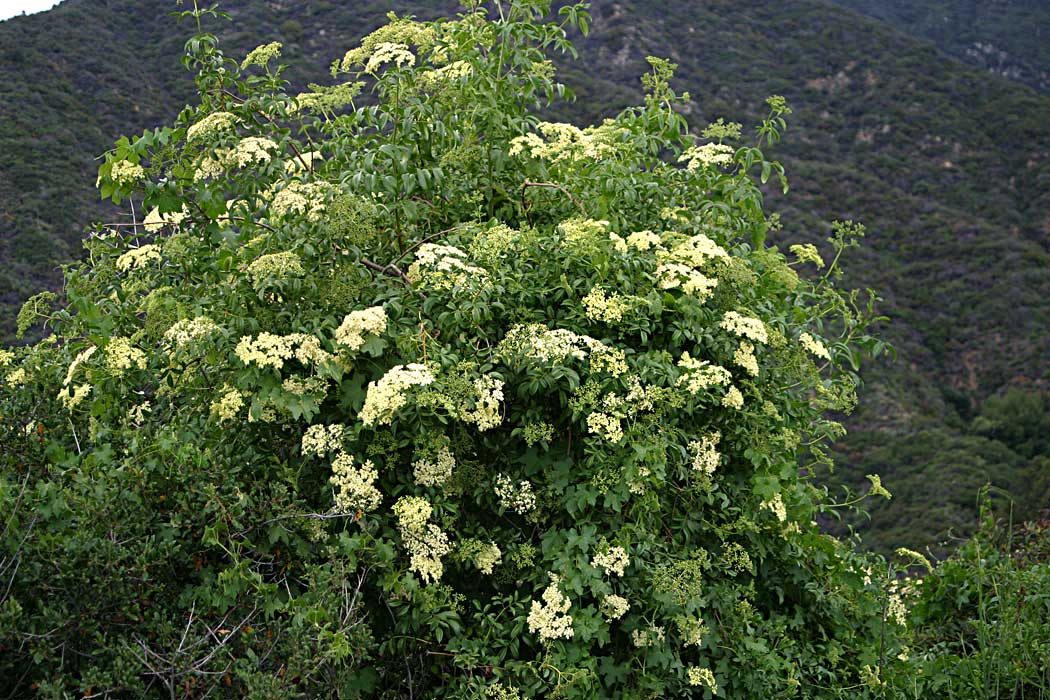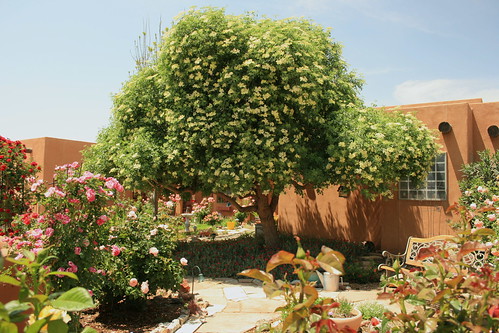 |
| Photo: Mine |
Viburnum opulus Woodland Shrub-like tree. Common name examples Olvon (Swedish) - Guelder-rose (Dutch) - European Cranberry (British)
 |
| Olvon Bär - Viburnum opulus |
 |
| European Elderberry Tree along the Önskevädersgatan Trolley Stop |
This is one of those more familiar trees to many people. These clusters to the left in the photo were not quite ripe. People here are crazy about the Elderberry juice(Saft) here, the Elderberry Jelly or Jam(Sylt) and just general fresh eating of these berry clusters. I never experienced this in all my years of growing up in Southern California where Mexican Elderberry is everywhere and very productive. A drink is also made from the flowers in springtime. This tree is found in the wild everywhere here where the the forest opens up along the fringes of meadows.
 |
| Photo by Gabi Mclean Mexican Elderberry (Sambacus mexicana) |
 |
| by Gabi McLean |
 |
| Photo: Mine |
I have to admit I'm not sure what this small tree in the woods is, but there were two separate ones which every year have different coloured berries as seen below.
 |
| Notice the difference in colour, Every year has been the same. |
 |
| Northern European Hawthorn Tree |
 |
| Hawthorn |
 |
| Honeysuckle Flowers Still Blooming |
 |
| Honeysuckle vine loaded with Berries |
 |
| Honeysuckle Berries |
Audubon: "Mystery Solved: Invasive Berries to Blame for Turning Flickers’ Feathers Pink"
 |
| Photo: Mine |
I don't really know what this shrub is but it is used as an Ornamental in the commercial landscapes here. This is at the Eketregatan (Oak Tree Drive) Trolley Stop. I once saw a young lady in a hurry to catch a Bus and she stopped long enough to pick a cluster of these and put one in her mouth. That caught my attention so I did the same and they weren't bad. Now she wasn't exactly Swedish and I find many immigrants will eat the berries here. Near my house in the forest you'll see African Immigrant kids playing with Swedish kids and showing them what Bush foods are safe to eat and what are not. Leave to Africans to know their Bush foods, even in another country. *smile*
 |
| Cottoneaster Plant showing off it's Berries |
I know this was a berry themed page but I have to show off some beautiful flowers that are blooming with a vengeance despite the lousy weather over here. I couldn't pass these up.
 |
| Photo: Mine |
 |
| Photo: Mine |
 |
| Healthy example of a Jackdaw |
Both kept close together and followed one another around, almost touching one another. The pictures really don't do the behavior justice. I really needed a film as this was odd and yet entertaining. I felt sorry for them in a way because no doubt they may had been rejected by their own kind, but they found one another for companionship who had what appeared to be the same similar circumstances. Many animal species will have a cooperative behaviour at times for survival. Especially in things such as hunting and gathering food where each one has a unique set of skills the other lacks. Perhaps this is what was going on here. In any event, I wished I had had at the time a video camera to capture and document this spectacle.
 |
| Photo: Mine |
Neither picture really does justice for what I saw and observed. In fact when I stopped at first having their togetherness presence catch my eye, neither were really afraid of me. They were only 3 feet away going about their business. I just came back from Grocery shopping walking back from the Trolley on a pathway and had to take my camera out again. By that time they moved on. On a last minute note here for western Gardeners. I've got to go back to the Mexican Elderberry as a great landscape and wildlife plant, even IF you don't want to eat them. Here's an example of a great southwestern styled landscape where the Mexican Elderberry fits in nicely.
* Footnote from top
 |
| Photo from Dave's Gardens |





Berries - yes, many berry plants, but that's great the African kids can recognize edible ones by certain traits that far away! Scandinavia does not look that drab with those colors, I must say.
ReplyDeleteMexican Elder...needs water or an oasis here, but so common. Our little pond and it's few big horticultural fish were parroting how it "wasn't hardy" here, yet in all the valley areas and barrios, there were old ones like the one you show, as well as in the yards of numerous residents originally from El Paso or Las Cruces, where that is a common tree. Once again, the "experts" ate crow...it because they don't get where they are. In Abq, we are just cool enough, that they don't often go summer deciduous, like they do 200 miles south.
I bet they go summer-deciduous in inland areas of So Cal. But I remember all of them in the canyon mouths throughout. I think the same species, but a higher elevation provenance, occurs in SE Arizona and SW NM into El Paso, but you can never find them for sale - I wonder if our's are strongly winter-deciduous, which I would think they were.
All our Mexican Elder trees are from California plants, it is reported, and the leaf does look different than ours, plus from CA, it wants to grow all winter and even flower in warm periods...not always a good thing in the higher deserts. The 2/2011 freeze-killed many in Abq and especially El Paso down to the bottoms of the trunks. (in El Paso, early Feb they are already softer than Abq, since their spring growing season is 4 weeks ahead of us)
When up in the mountains above Preskit and the Hualapai mountains above Kingman AZ, we have gone hiking and seen the forest elderberry there in Arizona among the aspen Trees. They were always plentiful in producing especially on alluvial flood plains if there was no permanent surface waters.
DeleteI'm sure Mrs Christmas Mountain Oasis Ohl-Johnson has one or two
--